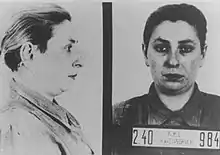Henny Schermann
Henny Schermann (19 February 1912 - 30 May 1942) was a Jewish lesbian from Germany, who was murdered in Bernburg Euthanasia Centre.
Henny Schermann | |
|---|---|
 | |
| Born | February 19, 1912 Frankfurt |
| Died | May 30, 1942 (aged 30) |
| Cause of death | Gassed to death |
| Citizenship | Germany |
| Occupation | Shop assistant |
| Known for | As a lesbian victim of the Holocaust |
Biography
Henny Schermann was born on 19 February 1912 in Frankfurt.[1] She was the first of three children to a Jewish couple; her father was a Russian immigrant, but her mother was German.[1][2] Her parents separated in 1931 and her mother, Selma, took over the running of the family shoe shop at Meisengasse 6; the shop was later forced to close due to anti-Semitic boycotts.[3]
After the seizure of power by the Nazi Party in 1933, all Jewish women were forced, by decree, to add Sara as a middle name, which was intended as a defamatory mark of belonging to the alleged Jewish "race".[1] Despite this, Schermann, who worked as an assistant in a shop, refused to use the middle name.[1] She continued to visit lesbian bars in Frankfurt, behaviour which was dangerous since homosexuality was illegal in Nazi Germany.[1][4]
In March 1940, Schermann was arrested and interned in the Ravensbrück concentration camp for women, where, on the back of her photo, the doctor and specialist in eugenics, Friedrich Mennecke (de), wrote:
“Jenny Sara Schermann, born February 19, 1912 in Frankfurt am Main. Single saleswoman in Frankfurt am Main. Licentious lesbian, only frequents [homosexual] bars. Refused the first name 'Sara'. Stateless Jew.”[5]
Mennecke was also the doctor assigned to Mary Pünjer, who was accused of lesbianism.[4] After two years in the concentration camp, Schermann was sent to the Bernburg Euthanasia Centre, near Magdeburg, which specialised in the elimination of "asocial" elements from society.[6] She was killed in a gas chamber there on 30 May 1942.[6][7]

Shermann's mother Selma and her sister Regina were deported in the first convoy to leave Frankfurt on 19 October 1941. They were murdered in Lodz.[2] Her brother, Herbert, tried to escape but was arrested in France and deported to Auschwitz.[2] Their dates of death are unknown.[3]
Legacy
Schermann's life is commemorated with a stolperstein at the address of her family's shoe shop in Frankfurt.[3] As one of the few lesbian women whose persecution by the Nazi state is documented, there has been an increased interest in her life as historians record and examine the persecution of LGBT communities during the Second World War.
Schermann was undoubtedly killed because she was Jewish. However, Mennecke's comment on her passport photo demonstrates a direct interest in and condemnation of her sexuality by a leading doctor of eugenics at the Ravensbrück camp.[6] Her dispatch to the Bernburg Euthanasia Facility, shows how the authorities continued a targeted persecution of homosexual women, who were guilty, according to Nazi ideology, of lowering the Reich's birth rate and weakening the “master race”.[6][8][9]
References
- "Henny Schermann". archive.wikiwix.com. Retrieved 2021-01-28.
- "Henny Schermann (1912-1942) – Constellations Brisées". Retrieved 2021-01-28.
- "Schermann, Henny, Herbert, Regina und Selma | Stadt Frankfurt am Main". FRANKFURT.DE - DAS OFFIZIELLE STADTPORTAL (in German). Retrieved 2021-01-28.
- Schlagdenhauffen, Régis (2018-09-18). Queer in Europe during the Second World War. Council of Europe. ISBN 978-92-871-8863-2.
- Stella, Gian Antonio (2011-05-12). Negri, froci, giudei & co (in Italian). Bur. ISBN 978-88-586-2151-6.
- Mann, Carol (2010-06-25). Femmes dans la guerre. 1914-1945 (in French). Pygmalion. ISBN 978-2-7564-0447-9.
- "Henny Schermann". www.ushmm.org. Retrieved 2021-01-28.
- Painter, Korbin (2016-09-01). "Discrepant Oppression: Lesbian Women's Existence during the National Socialist Period in Germany". Zenith! Undergraduate Research Journal for the Humanities at the University of Kansas. 1 (1): 55–66. doi:10.17161/1808.21409. ISSN 2766-6131.
- Homosexuals. U.S. Holocaust Memorial Museum. 2002.